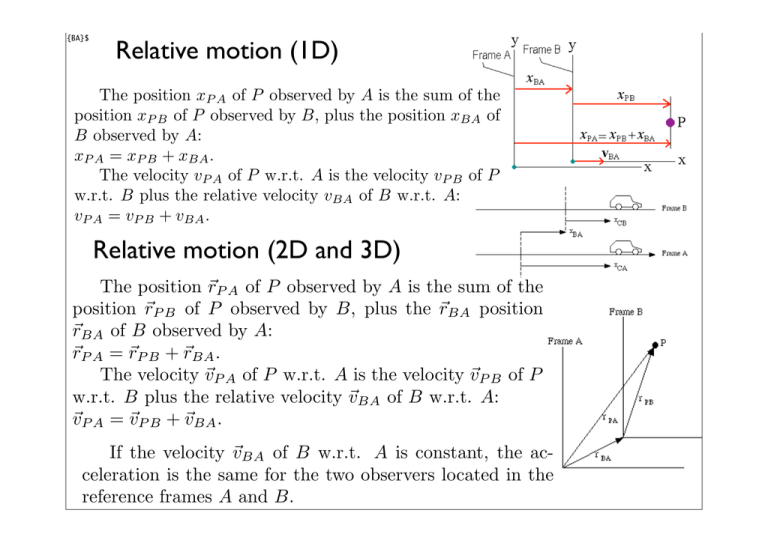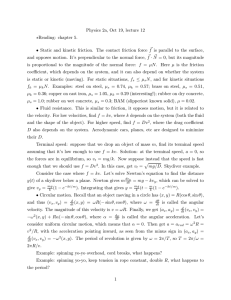Relative motion (1D) Relative motion (2D and 3D)
advertisement

$x_{BA}$
Relative motion (1D)
The position xP A of P observed by A is the sum of the
position xP B of P observed by B, plus the position xBA of
B observed by A:
xP A = xP B + xBA .
The velocity vP A of P w.r.t. A is the velocity vP B of P
w.r.t. B plus the relative velocity vBA of B w.r.t. A:
vP A = vP B + vBA .
Relative motion (2D and 3D)
The position �rP A of P observed by A is the sum of the
position �rP B of P observed by B, plus the �rBA position
�rBA of B observed by A:
�rP A = �rP B + �rBA .
The velocity �vP A of P w.r.t. A is the velocity �vP B of P
w.r.t. B plus the relative velocity �vBA of B w.r.t. A:
�vP A = �vP B + �vBA .
If the velocity �vBA of B w.r.t. A is constant, the acceleration is the same for the two observers located in the
reference frames A and B.
Newton’s laws
We consider the point of view of an observer
located on an inertial reference frame
First law (inertia) a free body, i.e. a body not subject
to external forces, (F� = 0), moves in a unifom rectilinear
motion: �a = 0 → �v = cost.
Second Law
F�tot
kg · m
= m�a , [ 2 = Newton = N]
s
m
F�tot = sum of all the forces applied to the body; m = mass
of the body, �a = acc. of the body in the direction of F�
Third law (action and reaction)
F�AB = −F�BA
F�AB = force (action) of the body A acting on the body B;
F�BA = force (reaction) of the body B acting on the body
A.
The forces F�AB and F�BA act on different bodies and the
directions are among the two bodies.
F�
�a =
�
F
m
Particular types of forces
m
g
Gravitational force
(approx: Earth surface and small difference of levels)
F
F�g = m�g
F�g = gravitational force (directed toward the center of
Earth); m = mass of the body; �g = free fall acceleration
g � 9.8 sm2 .
Uniform acceleration (free fall)
Elastic force (Hooke’s law)
F�k = −k�x
F�k = elastic force, is directed in the opposite direction with
respect to the displacement x of the body from the equilibN
rium position xeq = 0; k = elastic constant [ m
].
Harmonic motion
Elastic force (Hooke’s law)
F�k = −k�x
F�k = elastic force, is directed in the opposite direction with
respect to the displacement x of the body from the equilibN
rium position xeq = 0; k = elastic constant [ m
].
Harmonic motion
max (t) = −kx(t)
solution (check): x(t) = R cos ωt, R = xmax
� = x(0)
−mRω 2 cos ωt = −kR cos ωt, ⇒ ω =
k
m
Compare with Circular motion (components)
x(t) = R cos ωt , y(t) = sin ωt;
dx(t)
dy(t)
vx (t) =
= −Rω sin ωt , vy (t) =
= Rω cos ωt;
dt
dt
dvx (t)
dvy (t)
ax (t) =
= −Rω 2 cos ωt , ay (t) =
= −Rω 2 sin(1)
ωt
dt
dt
free body diagram
Constraint forces
�
N
� = −F�⊥ is
Normal force (or contact force) force N
applied by the support surface and is normal to the surface.
Inclined plane (frictionless)
� = F�⊥ = mg cos θ
−N
F�T ot
+
2T
+
Tension A cord — rope, cable, etc — (massless, frictionless and unstrechable) transmits the tension T� from a
body to another one.
T
T
T
T
Pulley wheel (massless, frictionless)
change direction to a tension.
Harmonic motion of a spring
max (t) = −kx(t)
solution: x(t) = R cos ωt, R = xmax = x(0)
�
−mRω 2 cos ωt = −kR cos ωt, ⇒ ω =
k
m
Harmonic motion of a pendulum (isochronism of small oscillations)
R
s(t) ∼ Rθ(t)
x(t) = R sin θ(t) ∼ s(t) = Rθ(t) for small angles.
Thus we can approximate sin θ(t) ∼ x(t)
R .
�
g
max (t) = −mg sin θ → max (t) ∼ −mg x(t)
⇒
ω
=
R
R
x(t) = R sin θ(t)
x(t)
Friction
frictional force
Parallel to the contact surfaces for sliding bodies (without rotation), such to obstacolate the the relative motion
of the bodies.
Static friction The bodies do not move.
Fµ S ≤ µ S N
FµS = static friction; N = normal force among the two surfaces; µS > µD coefficient of static friction.
Kinetic friction The bodies have relative motion.
Fµ D = µ D N
FµD = kinetic friction; N = normal force among the two
surfaces; µD coefficient of kinetic friction.
Maximal static force FµMS AX = µS N corresponds to the
the minimal force necessary to move a body against friction.
FµD = µD N
FµS
FµD
Centripetal force
v2
Fc = m
R
F�c = centripetal force to keep a body in a motion locally
circular of radius R and velocity v. It is directed toward
the center of the local circumference (the centrifuge force is
the reaction to that force, not applied to the body)
Gravitational force
m1 · m2
FG = −G
î
r2
Reciprocal attractive force between two masses m1 and m2
of distance (between their centres) r. The versor î denotes
the conjunction between the gravitational centres of attraction.
2
G = 6.673 · 10−11 Nkgm2 = Newton constant.
Gravitational acceleration on the Earth surface g =
G Mr2T � 9.8m/s2 , where MT is the Earth mass and r id
the Earth radius.
Kepler's laws of planetary motion
In astronomy, Kepler's laws of planetary motion are three scientific laws describing the
motion of planets around the Sun.
1. The orbit of a planet is an ellipse with the Sun at one of the two foci.
2. A line segment joining a planet and the Sun sweeps out equal areas during equal
intervals of time.[1]
3. The square of the orbital period of a planet is proportional to the cube of the semimajor axis (i.e. radius r )of its orbit.


